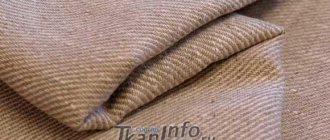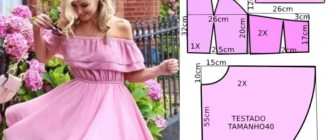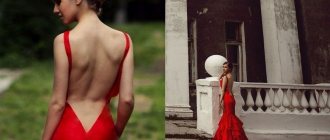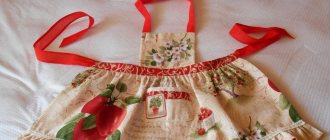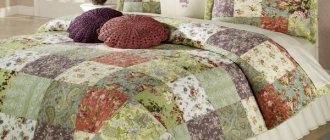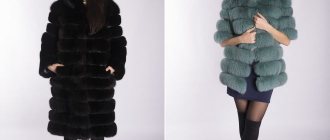Many girls like the opportunity to change their look during one evening. A good solution is to create a transformable dress, the pattern of which is quite simple. This part of the wardrobe is suitable for girls, regardless of their height, weight and waist circumference. Such dresses are made in half-sun and sun models, which eliminates the need to measure hip circumference. The cut and sewing of the dress is so simple that it is possible to make it yourself at home if you have basic sewing skills.
Required Tools
To sew a transformable dress, you must have the following tools:
- threads for basting parts of the dress;
- threads for working on a machine;
- large scissors;
- small scissors;
- matches or lighter;
- measuring tape;
- chalk or soap for cutting;
- sewing machine;
- sewing pins for connecting parts.
The only value that determines the size of a dress is the waist circumference. For a comfortable dress, the waistband width should be slightly smaller than this value (for a comfortable fit). Waist width is measured at the narrowest point on the torso. Measurements should be taken while standing, and the value should be recorded while inhaling. After measuring the girth, a measuring tape is tied around the waist. Another tape measures the required length of the dress. Length measurements should be taken while standing.
The girth and height of the chest do not matter for the cut and tailoring of the transformer. Wide straps starting from the waist and covering the chest can be tied in any place, which varies depending on the method of their attachment. Thanks to the simple cut and minimal number of measurements, it is possible to make such an outfit yourself at home.
Preparation of material and taking measurements
Initially, you should decide on the model of the outfit. If this is an item for everyday wear, then it is advisable to choose a medium length with a simple bodice. For the beach, you can choose more open options with a minimum length. An evening cut requires maximum length and an original cut of the upper part. To determine all these nuances for a pattern, it is worth taking measurements correctly, following this scheme:
- To determine the length of the hem, you need to attach the measuring tape to your waist and lower it to the desired length.
- Next, the waist circumference is determined. Divide the resulting figure by 4. At this stage, work with the skirt is completed.
- The next step will be taking measurements of the top. First, chest girth is determined. From this line, lower the perpendicular to the waist line. This will be the length of the top.
- To form a belt, it is worth measuring the circumference of the torso below the waist line - where the skirt begins.
- Determining the length of the ties. It is thanks to their design that diverse collars and cutouts are created.
You might be interested in this. Everything you need to know about tailoring car interiors.
Basic version of taking measurements
As for the preparation of the material, it is worth paying attention to the characteristics of textiles, especially satin, chiffon and natural silk.
Preparatory work
Before starting work, you should take measurements and buy the necessary material. The required amount of fabric is calculated depending on the required size of the product. The material you choose for sewing is knitted, which can be easily reshaped.
The advantage of a transformable dress is made of a material that has a monochromatic structure or with an abstract pattern. Large patterns may look unsightly with different ways of tying the dress.
When purchasing material, pay attention to its ability to wrinkle. It needs to be minimal. The fabric should easily change shape and there should be no folds on it. It is this material that will hold the shape of the straps well when creating different options for tying the transformer. If you change the binding, the folds will not be visible. This property of the material allows you to change looks during the evening without changing clothes. A girl will look good only in high-quality fabric and the ability to tie a transformer beautifully.
Large selection of transformer patterns!
Transformable clothing is a brilliant invention. Having such a thing in your wardrobe, you can endlessly change your daily looks - a cape turns into an elegant tunic, a scarf into a warm hood, or a blouse into a long dress. We have made a selection of various transformer items with patterns that can be sewn or knitted; you don’t even have to sew them, just overcast the edges. So let's get started!
I really liked the long version of the vest with an open back.
It looks especially beautiful if it is cut from the same fabric as the dress; it looks like one thing with a complex pattern. And the pattern of this vest, at the same time, is very simple. And you can wear it in different ways:
Another similar option with a closed back
Short version of the vest
If you sew a vest from knitted fabric, it can be worn as a dress
This vest is very similar to the transforming vest that we wrote about earlier:
You can find out how to sew such a transformable vest here
I don’t even know what to call the next option - a cape, vest or blouse. The whole secret is in the chosen fabric, which can easily be transformed into various types of clothing. There is no need for a pattern here. Rectangle with slits for arms. Before sewing such a transformer, try sewing it from cheaper fabric to see how it fits and how you will wear it.
- A simple sweater with a voluminous collar, which can be worn as a hood or a cape over the shoulders, radically changes the look.
The tunic - poncho - is sewn simply. Can be worn as a cape or as a dress if you sew a longer version.
A cape - a scarf for cold weather is just what you need! Thanks to the large loop, it can easily be transformed into a warm jacket with an asymmetrical hem.
Round transformable scarf. I hope that it will not be difficult for anyone to knit such a scarf with their own hands. What if you tie it with an elastic band? For example, French!
Like with this cardigan, for example. Lacing and buttons allow the cardigan to be secured in different places on the front and back.
- Look at the options for transforming cardigans made of knitted fabric
- How to wear a convertible cardigan
- Top transformer - ideal solution for hot summer
- A skirt can also be transformable
- Surprisingly, a jumpsuit can also be a transformer
- An interesting version of a transformable dress
- Another transformable dress
We hope our selection has inspired you! Success in creative work!
Stages of pattern creation and cutting rules
Patterns may vary in the length and cut of the skirt. The best choice would be a semi-sun skirt. When choosing a sun skirt, when cutting the fabric, a large amount of unused material remains.
The sequence of actions is as follows:
- Choosing the length and style of the skirt.
- Cut out the fabrics.
- Processing of slices.
- Sewing and heat treatment.
First, select the required length of the skirt. Depending on it, the required piece of fabric is determined. When choosing a half-sun and knee-length skirt, a piece of fabric 1500 mm wide and 2000 mm long is used. If the dress has a maxi length, a piece of fabric for the skirt is required up to 1 m. In this case, the length of the fabric cut is 4500 mm. These calculations are correct when choosing a semi-sun skirt. When choosing a sun flare, you need to double the length of the fabric cut. The diagram below is correct for sewing a dress with a skirt length of 600 mm, half-sun cut. Based on it, you can create a sun skirt pattern, and also adjust the length to the desired level.
The fabric is cut as follows:
- A piece of fabric 2000 mm long and 1500 mm wide is laid out on a flat, smooth surface. The fabric is pre-smoothed.
- The cut of the skirt begins from the top edge. You need to draw two circles. The distance between them is 600 mm - this is the length of the skirt. The small girth circumference coincides with the waist girth value.
- When the skirt is drawn, the remaining piece of fabric is cut across the width into two wide straps. Their length coincides with the length of the piece of fabric and is 2000 mm. The width of the two straps is equal. They take up all the space left on the piece of fabric after cutting the skirt.
- A rectangle is cut out on the side of the skirt - this is a belt. The length of the rectangle should be equal to the waist circumference - 30 mm. The 30mm drop helps the waistband fit snugly around the waist as it is the main support. The width of this rectangle is selected individually and ranges from 7 to 9 cm.
After completing the above procedures, the parts are cut out of the fabric. The slices are being processed. When choosing fabric for sewing knitwear or oil, it is better to process the sections with fire or cut the material with hot scissors. When treating sections with fire, you should check the reaction of the fabric to the flame on a small section. It is better to use a lighter with a short flame. After processing the seams, sewing begins.
DIY transformable clothes - patterns
In the life of a modern woman, completely different situations can arise, so it is very important to always stay in shape and have an attractive appearance. Unfortunately, the current rhythm of life sometimes does not provide the opportunity to change an outfit in order to comply with a particular dress code. That's why modern designers offer transformable clothes.
These things are quite versatile and functional. During the day you can wear an office-style dress, and by evening it will turn into an open evening dress. Interested? Then we offer you ideas on how to sew transformable clothes with your own hands - patterns will help you quickly understand the whole technology.
The process is simple and can be done even by those who have basic sewing skills.
Sew a transformable dress
We bring to your attention 2 original examples of making transformable dresses yourself. The most important thing is to make the correct cutting. All other work will take you no more than 5 minutes.
Important! The main advantage of sewing such things yourself is the fact that in the end you will get designer transformable clothes, which no one else will have analogues.
Example No. 1
In this case, it is best to purchase a piece of light fabric, or knitwear. It is desirable that it be monochromatic. This is due to the fact that in the future, when wearing the finished product, there will be no difficulties in combining it with other things.
Important! For greater originality, you can purchase another piece of the same fabric, just a different color or shade, which will be combined with the main one. Thus, your finished product will be double-sided, which will add even more functionality and practicality to it.
In addition to fabric, to sew a dress you will also need:
- Paper for making a pattern;
- Pencil;
- Scissors;
- Sewing needles;
- Sewing machine;
- Threads in the color of your chosen fabric;
- Sewing pins;
- Soap or tailor's marker.
Once all the tools and materials necessary for the work have been prepared, you can proceed directly to the manufacturing process. The progress of work consists of the following stages:
- Create a pattern according to your parameters. Measure the desired length of the skirt and mark it as well.
- Take the fourth part of the pattern and transfer it to the fabric.
- Fold the fabric in four and cut out the main element of the future product.
- Cut a belt from fabric for the future dress. It should be 25 centimeters wide and 75 centimeters long.
- Lay out the remaining fabric for the belt loops on the floor.
- At a distance of 30 centimeters from each other, measure two longitudinal lengths and secure them with tailor's pins.
- Along the marked lines, cut 2 blanks for belt loops.
- Unfold the skirt on a flat surface, and arrange the belt loops so that they lie flat.
- Place the belt loops overlapping each other with an overlap width of about 10 centimeters. Secure them in this position.
- Attach the belt loops to the inside of the skirt.
- Take the belt and fold it in half. Attach it to the skirt, securing it with sewing pins.
- Sew the belt to the skirt.
Important! To attach the belt. It is not necessary to use threads that match the color of the dress. You can safely use contrasting ones for these purposes, since they will not be visible during operation anyway.
- Finally sew all the elements of the product.
That's it, your transformable dress is ready! All you have to do is tie it correctly.
Important! It can be worn with a slight slouch or a fitted version on both loops. For a festive bow, you can tie it over one shoulder. You can complement this outfit with various accessories.
Example No. 2
If the previous version was more presentable, this transformable dress will be an excellent everyday outfit, as well as for relaxation. The only difference with the previous one is that this model also has a top. The progress of work is as follows:
That's it, your new dress is ready! There are plenty of options for how you can wear it. The most important thing is to show your imagination and creativity.
Sew a transformable cardigan
In order to sew such a cardigan, you will need the following tools and materials:
- A piece of fabric;
- Fur lining;
- Threads in the color of the main fabric and fur:
- Needles;
- Scissors;
- Sewing machine;
- Tailor's pins;
- Soap or tailor's marker;
- Pattern paper;
- Pencil;
- Tape measure.
The work order is as follows:
- Create a pattern. To do this, simply draw two rectangles on paper measuring 150x100 centimeters and 150x50 centimeters.
Important! The above sizes may vary depending on your individual parameters.
- Cut out the elements from paper. Take the largest one and fold it in half.
- From the fold line, measure half the width of the back, and also make marks at a distance of 30 centimeters from each other along the top line.
- Connect the dots.
- Measure the height of the armhole and cut it out.
- Create a sleeve pattern.
- Transfer all the patterns to the fabric and cut out the elements of the future product.
- Sweep everything together, try it on and make adjustments.
- Sew the finished cardigan and decorate it with faux fur.
Important! If desired, instead of fur, you can use a brooch or belt to decorate such a cardigan.
Video material
Sewing transformable clothes with your own hands is quite simple and anyone can do it, even a beginner.
However, if you show your imagination, you can create a fabulous number of different bows from such simple things.
We hope that our master classes will help you completely update your wardrobe with multifunctional items so that in the end no situation will unsettle you, and you will always remain on top.
Sewing technology
The cut transformable dress consists of 4 parts:
- skirt;
- 2 straps;
- belt.
If you choose a model with a sun skirt, it is sewn from two pieces of fabric to save material. In this case, the number of parts increases by one unit. You can cut out the sun model's skirt from a single piece of fabric, but in this case a larger piece of fabric is needed.
To sew a dress, you should follow a certain sequence:
- Baste the skirt to the belt. The length of the belt is several centimeters shorter than the waist circumference. The belt must be slightly tensioned when basting parts. In this case, the dress will be securely fastened at the waist.
- Initially, all seams are made by hand using a needle and thread. After sewing the skirt and waistband together, the back seam is formed. The belt and skirt are sewn into one piece. After this operation, it is recommended to try it on and make sure that the belt sits evenly at the waist.
- Then you should baste the straps. You should choose the exact location of the straps on the belt by folding the outfit in half. In this case, the back seam located on the waistband of the skirt should be on the left, and the center of the front of the outfit on the right. The fold formed on the right will be the center for basting the parts. First, one strap is basted on the narrow side, then the same is done from the second strap.
- All operations performed are repeated on a sewing machine. After this, the threads that were used to connect the pieces of the outfit manually are removed. The dress can be heat treated.
A transformable dress is an outfit that girls love for its versatility and practical cut, which is also quite easy to sew.
The choice of strap tying method allows girls to choose a look depending on their mood. The price for such an outfit is minimal, since making it at home saves money. The opportunity to buy a piece of fabric yourself allows girls to choose a beautiful pattern depending on their desires or make a monochromatic outfit.
Popular transformable dresses
With one movement of your hand, you can change your entire wardrobe and at the same time leave a couple dozen more fashionable styles in stock. A dress for one evening and for every day, for strict ladies and playful girls, for modest women and chic beauties - popular transformable dresses
suitable for every woman.
For those who do not yet know what a transforming dress is, let us explain... Back in 1976, Lydia Silvestra demonstrated to the press more than 100 variations of dresses made from one piece of material.
The original pattern allows you to “fly” transform the dress into fashionable trousers, a skirt, a sundress, a hoodie with a hood, a luxurious evening dress, and so on ad infinitum. This dress is called Infinite Dress - endless dress
.
The success was so enormous that 35 years later, her creation remains in fashion and attracts more and more new fans.
Relatively recently, analogues of endless dresses from Donna Karan
,
Picaro Puck
,
Emami
,
2Birds Dress
by Adriana Goldman,
Hayley Starr
,
Victoria's Secret
... No less original models and a varying number of transformations for every taste and budget.
For example, Donna Karen's transformable dress has 7 variations - it costs $895, with it it is easy to create various stylish looks - from classic to extravagant. There is a more economical option - Fancy Infinite Dress from designer Hayley Starr - 110 variations for $280.
Victoria's Secret offers its transformable collection - 2 variations of an endless dress (tight-short-sexy - $79 and long-airy-flirty - $85), as well as a jumpsuit with “ears” for $109. Such a new addition to your wardrobe will not leave anyone indifferent.
What will really be difficult to decide on is the choice.
Those who love to sew can use simple patterns and make such dresses with their own hands. Regular knitted fabric, silk or spandex will do. Choose a reversible material that has good stretch and drape, but keep in mind that stretch fabrics are quite difficult to sew.
Transformable dress pattern EMAMI
Picaro Puck transformable dress pattern
How to sew a transformable dress Infinite Dress
Transformable tunic: simple and easy
The feature of a transforming tunic is important during warm summer days, especially for those who love a comprehensive tan. The garment allows you to vary the degree of coverage of the back and shoulder.
To determine the required amount of material, we take measurements: clothing length (LO) - measurement of the base of the shoulder to the desired length of the product plus about 5 cm for seams, hip circumference below the waist (OB), front length (FL) - from neck to waist, back length ( DS). For the product we use light, wrinkle-resistant fabrics - chiffon, poplin or cambric.
Next, using the formula OB:2+OB:2:3, we obtain the minimum width of the front and back clothing parts (WHI). Here we make the same seam allowances. Multiplying the resulting value by 2, we determine the length of the product. Since the standard length of the fabric is up to 150 cm, add 20 cm for the waistband and seams. Did it turn out to be more than 70 cm? We take two lengths of canvas. To summarize, it is easier to calculate: if the OB is more than one meter, two lengths of fabric are needed.
Next, we make the pattern according to the diagram:
Or:
First cut out the front and back, then sew along the central seams. We adjust the skirt fabric to the finished width of the product.
The first version of the pattern requires sewing the shoulder seams. When planning the top of the product, gather the seams with elastic, processing them in a zigzag manner. Sew edge seams along the length.
The measurements of the circumference near the arms and neckline are purely individual, so it is easier to tighten it with an elastic band, stretching it into the shoulder seams. To loosely fit the product, sew the side seams 10 cm down from the expected sleeve measurements.
To emphasize the silhouette, tie the waist with a belt. You can wear a transformable tunic by covering your shoulders - pull the elastic on the shoulders, with open shoulders - the elastic is tightened at a level just above the chest.
